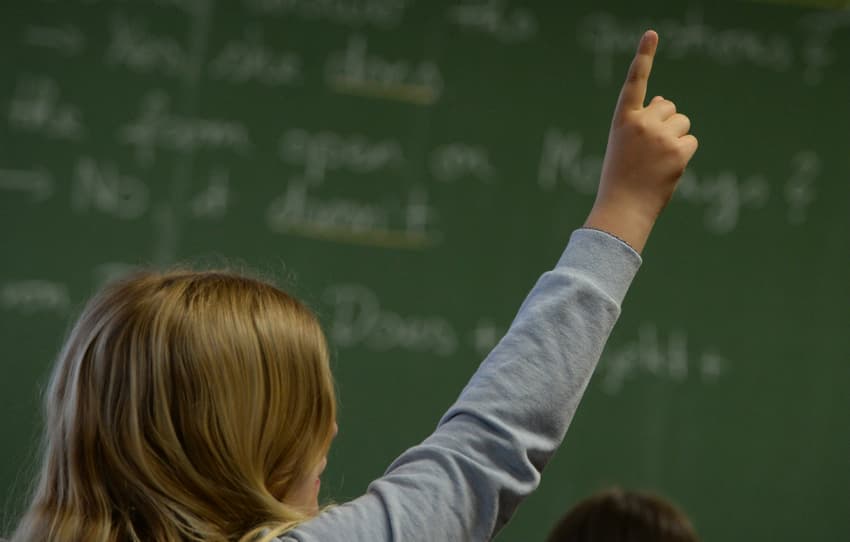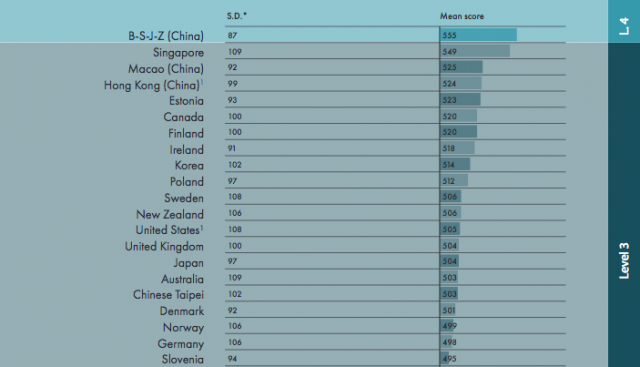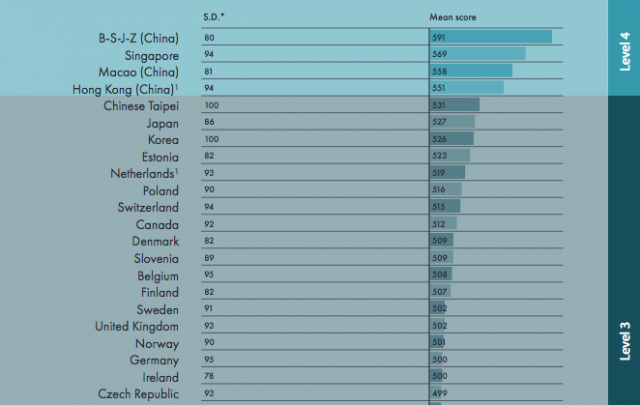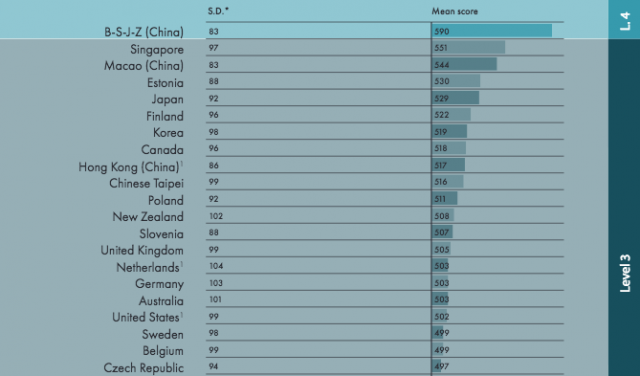'Room for improvement': How Germany's schools compare to the rest of Europe

Germany was among the top European countries in the latest PISA report measuring the abilities of students across the world – but performances have fallen compared to previous years.
The Organization for Economic Cooperation and Development (OECD) published its highly anticipated Programme for International Student Assessment (PISA) report for 2018 on Tuesday, comparing the ability of 15-year-olds from 79 countries throughout the world.
Students in Germany scored above the OECD average in all three areas tested, however they did worse than in previous years. According to PISA, reading levels fell close to 2009 results, reversing most of the gains observed up to 2012.
In science, mean performance was below 2006 levels; while in mathematics PISA 2018 results lay significantly below those of 2012 results.
How does education in Germany compare to other countries?
Students in Germany scored above the OECD average in reading (498 points) as well as in maths (500 points) and science (503 points).
However, Germany did not make it into the top group. In all subject areas, young people in Germany performed worse on average than in Estonia, Finland, Hong Kong, Ireland, Poland and Singapore.
Below is the performance ranking for reading (OECD average is 487)

Source: OECD
Germany’s average performance in at least two of the three subjects was not significantly different from that of Australia, Belgium, the Czech Republic, France, Ireland, New Zealand, Norway, Slovenia, Sweden, the UK and the US.
But students’ performances were lower in all three subjects in comparison with Beijing, Shanghai, Jiangsu and Zhejiang (China), Canada, Estonia, Finland, Hong Kong (China), Ireland, Korea, Macao (China), New Zealand, Poland and Singapore.
Below is the performance ranking for mathematics (OECD average is 489)

Source: OECD
In 2001, the OECD compared education levels in several countries for the first time. The results triggered the "Pisa Shock" in Germany because they were mediocre at best. It was also found that success at school depends much more on the pupil's family and background than in other nations.
What exactly is the PISA study?
The PISA study is the largest international comparative school performance study. This time around 600,000 pupils from 79 countries took part, in Germany almost 5,500 students took part.
Since 2000, hundreds of thousands of students aged 15 have been tested every three years in the fields of mathematics, reading and the natural sciences.
This year the main focus was on reading competence. The tests are now carried out primarily on computers, with pupils having to complete various tasks.
What are some of the other findings?
The report found that privileged pupils in Germany have a clear performance advantage over those who are socio-economically disadvantaged.
The gap in reading performance between advantaged and disadvantaged students in Germany is large – and increased by nine score points since 2009.
The 25 percent most socio-economically advantaged students outperformed the 25 percent most disadvantaged students by 113 score points – 24 points larger than the OECD average of 89 score points.
However, some 10 percent of disadvantaged students in Germany were able to score in the top quarter of reading performance, similar to the OECD average of 11 percent.
Below is the performance ranking for science (OECD average is 489)
 Source: OECD
Source: OECD
Immigrant children need more support
Meanwhile, the proportion of immigrant students in Germany grew by four percentage points between 2009 and 2018, from 18 percent to 22 percent.
They are defined as students whose both parents were born outside the test country. Germany is considered a long‐standing destination country with many settled, low‐educated immigrants.
The PISA report found one in two immigrant students was socio-economically disadvantaged.
"The gap in reading performance between immigrant and non-immigrant students stood at 63 score points and remained relatively large (17 points) after accounting for students’ and schools' socio-economic profiles," said the report.
However, in spite of their relative socio-economic disadvantage, 16 percent of immigrant students scored in the top quarter of reading performance.
The report said integrating pupils is a challenge.
"In many countries, immigrant students tended to be less likely than their native-born peers to attain the minimum level of proficiency in reading," said the report.
"Targeted support for immigrant students would seem most appropriate in Belgium, Denmark, Finland, Germany, Iceland, the Netherlands, Slovenia and Sweden, where at least five percent of students have an immigrant background.
"These students are at least three times as likely as students without an immigrant background to score below the minimum level of proficiency in reading."
During the presentation of the figures in Berlin on Tuesday, OECD representatives said integration of children with a migrant background was a major challenge for Germany, reported Focus Online.
READ ALSO: 6.2 million in Germany 'cannot read or write German properly'
"One of the factors behind the decline in performance could be the increased demands placed on the education system since the refugee crisis," the OECD stated.
Girls performing better than boys
Girls in Germany significantly outperformed boys in reading by 26 points (compared with the OECD average gender gap of 30 score points).
The gap was narrower than that observed in 2009 (40 points). In Germany, girls scored seven points lower than boys in mathematics, which is wider than the average gender gap in maths across OECD countries (five points).
Girls and boys performed similarly in science.
Are students happy?
In Germany, as on average across OECD countries, 67 percent of students reported that they are satisfied with their lives.
Some 92 percent of students in Germany reported sometimes or always feeling happy and about 4 percent of students reported always feeling sad. By contrast, 23 perent of German students reported that they are exposed to bullying at least a few times a month (the OECD average is 23 percent).
Did we learn anything else?
In addition to the tests, the subject of "reading for pleasure" was also surveyed.
The comparison showed that young people's interest in reading is declining. Every second 15-year-old respondent in Germany said: "I only read when I have to read" or "to get the information I need".
What's the reaction?
Although the current results are not dramatic, Alexander Lorz, President of the Conference of Education Ministers and CDU Minister of Culture in Hesse said, they do not meet the expectations politicians, teachers and parents have of the German education system. "There is still room for improvement," said Lorz.
Germany’s Education Minister Anja Karliczek said Germany should not be satisfied with the results, reported DPA.
Karliczek emphasized that Germany has a good school system. "But we cannot be satisfied with that. Other countries are passing us by," she said.
The government is to focus on providing improved reading programmes in early childhood.
Kristina Reiss, PISA coordinator for Germany, described the results as "quite acceptable", reported Spiegel. However, the country could do better.
"Our ambition must be greater than to be a little above the OECD average," said Reiss. Compared to previous PISA results, however, the current figures are an important success for Germany.
There are only a few countries that have "achieved such a positive overall development on a comparable basis", said Reiss.
But the results also show that there is a need for action. For example, the proportion of underachieving young people in all three areas is considered "unquestionably too high".
Comments (1)
See Also
The Organization for Economic Cooperation and Development (OECD) published its highly anticipated Programme for International Student Assessment (PISA) report for 2018 on Tuesday, comparing the ability of 15-year-olds from 79 countries throughout the world.
Students in Germany scored above the OECD average in all three areas tested, however they did worse than in previous years. According to PISA, reading levels fell close to 2009 results, reversing most of the gains observed up to 2012.
In science, mean performance was below 2006 levels; while in mathematics PISA 2018 results lay significantly below those of 2012 results.
How does education in Germany compare to other countries?
Students in Germany scored above the OECD average in reading (498 points) as well as in maths (500 points) and science (503 points).
However, Germany did not make it into the top group. In all subject areas, young people in Germany performed worse on average than in Estonia, Finland, Hong Kong, Ireland, Poland and Singapore.
Below is the performance ranking for reading (OECD average is 487)

Source: OECD
Germany’s average performance in at least two of the three subjects was not significantly different from that of Australia, Belgium, the Czech Republic, France, Ireland, New Zealand, Norway, Slovenia, Sweden, the UK and the US.
But students’ performances were lower in all three subjects in comparison with Beijing, Shanghai, Jiangsu and Zhejiang (China), Canada, Estonia, Finland, Hong Kong (China), Ireland, Korea, Macao (China), New Zealand, Poland and Singapore.
Below is the performance ranking for mathematics (OECD average is 489)

Source: OECD
In 2001, the OECD compared education levels in several countries for the first time. The results triggered the "Pisa Shock" in Germany because they were mediocre at best. It was also found that success at school depends much more on the pupil's family and background than in other nations.
What exactly is the PISA study?
The PISA study is the largest international comparative school performance study. This time around 600,000 pupils from 79 countries took part, in Germany almost 5,500 students took part.
Since 2000, hundreds of thousands of students aged 15 have been tested every three years in the fields of mathematics, reading and the natural sciences.
This year the main focus was on reading competence. The tests are now carried out primarily on computers, with pupils having to complete various tasks.
What are some of the other findings?
The report found that privileged pupils in Germany have a clear performance advantage over those who are socio-economically disadvantaged.
The gap in reading performance between advantaged and disadvantaged students in Germany is large – and increased by nine score points since 2009.
The 25 percent most socio-economically advantaged students outperformed the 25 percent most disadvantaged students by 113 score points – 24 points larger than the OECD average of 89 score points.
However, some 10 percent of disadvantaged students in Germany were able to score in the top quarter of reading performance, similar to the OECD average of 11 percent.
Below is the performance ranking for science (OECD average is 489)
 Source: OECD
Source: OECD
Immigrant children need more support
Meanwhile, the proportion of immigrant students in Germany grew by four percentage points between 2009 and 2018, from 18 percent to 22 percent.
They are defined as students whose both parents were born outside the test country. Germany is considered a long‐standing destination country with many settled, low‐educated immigrants.
The PISA report found one in two immigrant students was socio-economically disadvantaged.
"The gap in reading performance between immigrant and non-immigrant students stood at 63 score points and remained relatively large (17 points) after accounting for students’ and schools' socio-economic profiles," said the report.
However, in spite of their relative socio-economic disadvantage, 16 percent of immigrant students scored in the top quarter of reading performance.
The report said integrating pupils is a challenge.
"In many countries, immigrant students tended to be less likely than their native-born peers to attain the minimum level of proficiency in reading," said the report.
"Targeted support for immigrant students would seem most appropriate in Belgium, Denmark, Finland, Germany, Iceland, the Netherlands, Slovenia and Sweden, where at least five percent of students have an immigrant background.
"These students are at least three times as likely as students without an immigrant background to score below the minimum level of proficiency in reading."
During the presentation of the figures in Berlin on Tuesday, OECD representatives said integration of children with a migrant background was a major challenge for Germany, reported Focus Online.
READ ALSO: 6.2 million in Germany 'cannot read or write German properly'
"One of the factors behind the decline in performance could be the increased demands placed on the education system since the refugee crisis," the OECD stated.
Girls performing better than boys
Girls in Germany significantly outperformed boys in reading by 26 points (compared with the OECD average gender gap of 30 score points).
The gap was narrower than that observed in 2009 (40 points). In Germany, girls scored seven points lower than boys in mathematics, which is wider than the average gender gap in maths across OECD countries (five points).
Girls and boys performed similarly in science.
Are students happy?
In Germany, as on average across OECD countries, 67 percent of students reported that they are satisfied with their lives.
Some 92 percent of students in Germany reported sometimes or always feeling happy and about 4 percent of students reported always feeling sad. By contrast, 23 perent of German students reported that they are exposed to bullying at least a few times a month (the OECD average is 23 percent).
Did we learn anything else?
In addition to the tests, the subject of "reading for pleasure" was also surveyed.
The comparison showed that young people's interest in reading is declining. Every second 15-year-old respondent in Germany said: "I only read when I have to read" or "to get the information I need".
What's the reaction?
Although the current results are not dramatic, Alexander Lorz, President of the Conference of Education Ministers and CDU Minister of Culture in Hesse said, they do not meet the expectations politicians, teachers and parents have of the German education system. "There is still room for improvement," said Lorz.
Germany’s Education Minister Anja Karliczek said Germany should not be satisfied with the results, reported DPA.
Karliczek emphasized that Germany has a good school system. "But we cannot be satisfied with that. Other countries are passing us by," she said.
The government is to focus on providing improved reading programmes in early childhood.
Kristina Reiss, PISA coordinator for Germany, described the results as "quite acceptable", reported Spiegel. However, the country could do better.
"Our ambition must be greater than to be a little above the OECD average," said Reiss. Compared to previous PISA results, however, the current figures are an important success for Germany.
There are only a few countries that have "achieved such a positive overall development on a comparable basis", said Reiss.
But the results also show that there is a need for action. For example, the proportion of underachieving young people in all three areas is considered "unquestionably too high".
Join the conversation in our comments section below. Share your own views and experience and if you have a question or suggestion for our journalists then email us at [email protected].
Please keep comments civil, constructive and on topic – and make sure to read our terms of use before getting involved.
Please log in here to leave a comment.